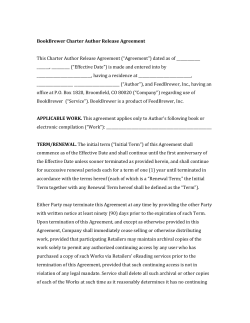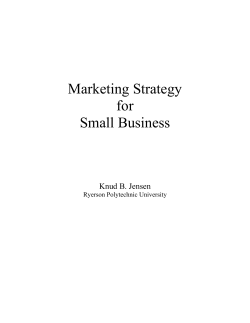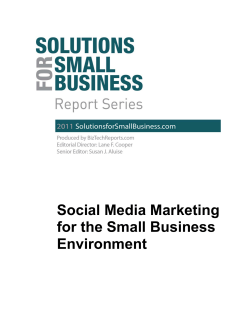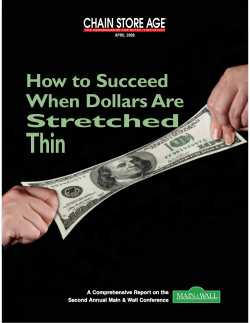
RETAILERS AT THE CROSSROADS: HOW TO DEVELOP NEW PROFITABLE
RETAILERS AT THE CROSSROADS: HOW TO DEVELOP NEW PROFITABLE GROWTH STRATEGIES June 2003 Management consulting at Charles River Associates Retailers at the Crossroads: How to Develop New Profitable Growth Strategies Many industries have been hit hard by the current recession, but none more so than the retail sector. A number of large U.S. chains that were once household names – Ames, Bradlees, Caldor and Montgomery Ward, to name a few – have folded. Others, such as Toys “R” Us, J.C. Penny, Radio Shack and AutoZone have been closing outlets to avoid a similar fate. As these retailers have struggled, a select number of major chains has found ways to increase earnings and sales. Companies such as Staples, Bed Bath & Beyond and Office Depot have consistently posted top-quartile earnings growth relative to peers. Furthermore, food retailers, while representing only 19% of retail sales over the past decade, have captured 28% of industry profits. What – if anything – are these companies doing differently than their competitors? Our research and client experience indicate that to excel in today’s highly saturated retail markets, companies need to abandon the geographic expansionism that, ironically, created their original success. Instead, they need to initiate new management strategies based on profit-driven product selection and customer targeting. At the heart of the shift is the introduction of financial discipline into the marketing process. Retailers need to be ruthless about pulling unprofitable products from the shelves and avoiding highvolume but low-profit customer segments. This shift represents more than a stopgap to survive the downturn. Rather, as we will show, it signifies a major transition in how retailers will compete with each other in the future. It will require changes in culture, operations, strategy and finance. Those that develop the capabilities to manage product and customer profitability will have the earnings to support future investment and value growth. Those that stay focused on sales growth through square-foot expansion will find themselves with shrinking margins and less capital to invest in profitable growth – a sure recipe for competitive failure and shareholder disappointment. To maximize profits, retail companies need to excel in three areas. First, they need to approach the early years of their growth in the same way that Napoleon approached empire building: the more territory, the better. When they find a successful new retail format, such as a stylish clothing specialty store or a super-supermarket, they need to roll it out as quickly and as broadly as possible to preempt copy-cat competition. Second, once they saturate their markets with outlets, companies can sustain their earnings growth by improving the mix of products they sell. Shelves may be stacked with money-losing products that were helpful in attracting customers during the early growth phase, but which now create a drag on profitability. Finally, as gains from improved product mix level off, retailers need to alter their promotion, advertising and merchandising strategies to better respond to local market preferences (see Figure 1). Stores may be in locations that can no longer support profitable operations, or demographics may have shifted since the store opened. Most retailers have learned the skills associated with the first phase – real estate acquisitions and store openings. Few have the requisite management capabilities for the second two: improving product and customer profitability. Figure 1: Three Phases of Profitable Growth Phase 1 Phase 2 Phase 3 Pursuing Geographic Expansion Improving Product Selection Increasing Customer Value • Acquiring Real Estate • Developing the Supply Chain • Recruiting & Training Store Personnel • Building the Brand • Understanding Category Profitability • Eliminating Unprofitable Products • Managing the Product Offering • Understanding Customer Profitability • Targeting Desired Customers • Managing Customer Value Three Retail Management Strategies 2 Retailers at the Crossroads: How to Develop New Profitable Growth Strategies Strategy 1: Pursuing Geographic Expansion Retailers grow to national prominence by developing a successful store format, aggressively acquiring real estate and investing heavily in brand building. This strategy works well in the early phases of a company’s growth – and, in fact, is the only way to become a national company. The trouble begins, however, when the retailer becomes so big that its returns on incremental investment deteriorate and its earnings plateau. Soon, management fails to develop other ways to run the company. The most recent examples of this are the so called “category killers,” such as Circuit City, Staples, The Home Depot, Bed Bath & Beyond and Toys “R” Us. Seemingly coming from nowhere, 17 chains created successful store formats in one product category after another – consumer electronics, office products, home improvement products, white goods, toys and so on. By offering wide product selection and prices within their specific categories, these format innovators won over millions of consumers, transformed the operational methods of North American retailing and changed the look and feel of many Main Streets. In financial terms, they generated a third of the growth in market capitalization for the industry and earned nearly a third of the industry’s economic profits over the 1990s (see Figure 2). capabilities developed at corporate and/or through corporate programs. While these skills were important in the early years of their growth, the format innovators have saturated most markets. If retailers are to avoid flat or declining earnings in the coming years, they must master two alternative approaches to managing their operations. First, they will need to develop a more accurate understanding of the profitability of the different products they offer in their stores and more knowhow on how to position those products to take advantage of high margins and/or turns. Second, they will need a more accurate picture of which customer segments are profitable and an improved ability to position their products and stores to reach those customers. In short, the focus will have to shift from adding new stores to improving the profitability of existing stores, and with that a shift from corporate control to local autonomy and experimentation. Unfortunately, their performance as a group of late has been less impressive. In the last few years, while the group has been adding square footage at a rate of 14% per year, same-store sales have been increasing at only 2%. And, as highlighted in Figure 3, the economic profit for the group has been declining since 1999 as retailers continued to add square feet without accompanying profit gains. While the overall economic slowdown has played a role in declining sales and profitability, the main factor has been that these retailers have become overly reliant on their ability to roll out new stores – i.e., a geography-based management strategy. They excel at activities like real estate acquisition and construction, supply chain development and store personnel recruitment and training – 3 Retailers at the Crossroads: How to Develop New Profitable Growth Strategies Figure 2: Sales, Economic Profits and Market Value Growth in the U.S. Retail Industry (1990-2000) Distribution of Cumulative Sales (‘90-00) Distribution of Cumulative Economic Profits (’90-’00) All Other 2% Speciality 12% Food 19% Drug 6% Discount 13% Dept. Store 19% Specialty Food 8% 10% Food 28% Wal-Mart 39% Format Innovators 14% Wal-Mart 17% Distribution of Market Value Growth (’90-00) Format Innovators 31% Drug 8% Discount 6% Dept. Store 6% Format Innovators 30% Wal-Mart 32% Format Innovators Include: Abercrombie & Fitch, AutoZone, Barnes & Noble, Bed Bath & Beyond, Best Buy Circuit City, Claire’s Stores, Gap, The Home Depot, Intimate Brands, Linends ‘n Things, PETsMART, Stables, The Sports Authority, Toys “R” Us Figure 3: Square-Foot Expansion Versus Profitability Square Footage (M) Economic Profit ($M) 450 5000 400 Square Footage 350 4000 300 250 3000 200 Economic Profit 150 100 2000 50 1000 2001 2000 1999 1998 1997 1996 (50) 1995 0 0 Strategy 2: Improving Product Selection During their rapid geographic expansion, retailers typically bring together a vast array of products to attract customers. This may make economic sense at first, as retailers are trying to generate excitement and offer convenience. But over time, rapid growth can conceal the fact that many of these products do not make money for the company. The next step is to become more selective in which products to offer and which to discontinue. There are three things in particular to focus on: 1. Understanding Category Profitability – It is important for retailers to have an accurate understanding of which products are contributing to the value of the company. Typically, product profitability is measured superficially – in terms of gross margin or operating contribution, for example. But each product’s profitability is also affected by shared costs, such as store operations, head office marketing and administrative expenses. It is also affected by capital costs, such as the holding cost of inventory or the capital cost of physical facilities that are related to the product category (see Figure 4). Unfortunately, most companies have not developed the ability to track these costs on a productspecific basis and thus lack a clear picture of which products are economically profitable. When retailers do study product economics at this level of detail, however, they typically find that a third of their square footage is being tied up by products that do not make an economic profit (above the cost of capital) for the store. Another third of space is typically allocated to product categories that have break-even economics. And the final third of space actually creates more than 100% of the economic profit. Unfortunately, most retailers are unaware of which third of their products is generating all the profit (see Figure 5). 4 Retailers at the Crossroads: How to Develop New Profitable Growth Strategies Figure 4: Measuring Total Product Profitability $ Traditional Profitability Measures “Fully Loaded Profitability Measures Revenue Net Sales Price COGS Gross Margin Direct Marketing Expense Operating Contribution Shared Services Taxes Capital Costs Economic Profit Figure 5: Economic Profit by Merchandise Categories Economic Profit ($/sq.ft.) 2,000 Low Profit Lowfit/low profit Average $250 EP/Sq. Ft. 1,500 1,000 ROC = (3.2%) 55% of Assets 500 0 ROC = 82.7% 45% of Assets (500) (1,000) Product Ranges A B C D E F G H I J K L M N O P Q R S T U V W X 5 Retailers at the Crossroads: How to Develop New Profitable Growth Strategies 2. Eliminating Unprofitable Products – A more accurate understanding of product economics can help retailers put their existing square footage to more profitable use. This requires a “house cleaning” to prune those categories that are creating a drag on the bottom line, which in turn may require major changes in corporate and business unit strategy. For example, one reason that stores end up with so many unprofitable products is that corporate headquarters has a policy of shipping each product to all stores – and in the same quantity. As a result, because of local market differences, some stores run out of inventory for products that sell well in their local market and are at the same time overstocked on products that don’t sell well. Here, the answer lies in refining the corporate policy so that instead of prescribing the exact product assortment to the local store, the corporate headquarters offers a menu of products that local stores can choose from in the quantities they need. This can result in a higher percentage of the store space being used to sell high-margin and/or quickturn products. Executives grew the business smartly, picking a few categories, like cosmetics, where they had a pre-existing brand position on which to build. Over time, Boots offered new products within the category and improved its brand communication both in the UK media and in stores. Most importantly, the company gained new skills in brand management, product development and marketing communications on top of its category planning expertise.. Boots has gone on to create own brands that are leaders in a number of categories, including Botanics and Soltan personal care products, over-the-counter health products like Strepsils cough/cold medicine and Boots brand vitamins. The pay-off for Boots has been the capture of significant gross margins that would have ordinarily gone to global consumer products companies. Even more remarkable is that Boots has accomplished this without alienating the major consumer brands, by creating products that nicely complement the strongest and best brands from Procter & Gamble, L’Oréal, Gillette and others. Strategy 3: Increasing Customer Value 3. Managing the Product Offering – One of the more impressive examples of marketing highmargin products is the UK health and beauty retailer Boots, which over the last decade has become an industry leader in knowing where it makes money in its product portfolio and how to exploit that understanding through merchandising, store layout and other marketing techniques. Even when unprofitable geographic expansion has been halted and product lists pruned, companies squander resources chasing the wrong customer segments. In order to maximize earnings, there is a third strategy to master: increasing customer lifetime profitability, i.e., understanding and maximizing the profitability of a customer’s longterm relationships with the retailer. For example, the company recognized that its “own brand” toiletry and cosmetics products were doing extremely well. These products weren’t low-price private labels; instead, they were distinct brands created by Boots as real alternatives to global consumer brands. Management realized that the chain’s ubiquity in the UK (more than 1,400 stores) presented an opportunity to increase the percentage of own brand products in its product mix. Doing this requires knowing which segments of the customer base are profitable – down to individual names in some cases – and what will make those customers more profitable in the future. Knowing or predicting sales is not enough. It is also necessary to know all of the factors that contribute to the profitability of each customer segment, such as the total cost to serve each customer group. There are three basic elements to successful customer value management: 6 Retailers at the Crossroads: How to Develop New Profitable Growth Strategies 1. Understanding Customer Profitability – few retailers can say which of their customers are creating economic profit – and hence long term value. They may track revenue by customer using sales information from instore scanners, Internet purchases and catalog orders. Some may even track other information, such as cost of goods sold for the products customers purchase or directly targeted marketing spend per customer. But the idea of “fully loaded” customer economics as the basis for strategic decision making is not present in many retailers: Few companies take into account the amount of shared costs, back-office support, corporate wide branding expense and capital costs that each customer requires. This is becoming more feasible today as more retailers have the technology to identify individual customers and their purchasing patterns through loyalty cards, credit cards and automatic payment systems. When retail companies use this information to manage customer value, they usually see that economic profits are even more concentrated in customer relationships than within a product portfolio, i.e., very few customers are actually driving all the value creation of the retailer (see Figure 6). 2. Targeting Desired Customers – Customer profitability analysis as highlighted above helps retailers redirect their marketing strategies toward the highest-value customer segments. Consider the experience of a major clothing retailer, which had grown to prominence by serving highly profitable 40-60year-old, whitecollar professionals in largestore formats. Experiencing market saturation and being offered significant incentives by property developers, the retailer had decided to enter smaller local markets with a smaller store format. However, profitability at these smaller stores had been disappointing relative to larger stores, due mostly to lower sales per square foot. The reason? The residential areas surrounding the smaller stores had a much smaller numberof customers in the 40- 60-year-old, white-collar professional segment (see Figure 7). In response, the retailer used a database to track the purchasing histories of credit card holders who shopped at the smaller stores. The database revealed the relative sales and profitability of those customers down to individual customer names. What the company discovered was that the most profitable customer segments in the smallstore format looked very different than those in the largestore format. In many cases, the most profitable customers were 20-40- year-olds, who were more interested in designer fashions. 3. Managing Customer Value – Understanding which customers are the most valuable to the retailer and what/why they buy allows companies to increase the total economic profit contribution of the customer base. At the same time, it benefits the customers that management is targeting with a better offer and/or price. For example, leading retailers are using point-of-sale data to capture purchasing information and forecast purchase patterns (and therefore profitability and value) over the lifetime of the customer relationship. This allows the company to tailor its customer acquisition and retention strategies, marketing communications and promotional policies based on the expected lifetime profitability of the customer. Customers benefit because the retailer understands their needs better and provides a superior selection in return. In the case of the clothing retailer discussed above, management chose a number of trial stores to roll out a new format targeting younger customers. Customer purchase history was analyzed to determine which products were of greatest interest to targeted customer segments. The analysis prompted significant adjustments to the merchandising mix according to style and price point, as well as targeted promotions and an investment in marketing and sales. The impact was dramatic: Two months into the experiment, the trial stores were outperforming the rest of the small stores. As a result, the retailer decided 7 Retailers at the Crossroads: How to Develop New Profitable Growth Strategies to implement the customer-focused strategy across all of its small stores. The Next Season of Profitable Growth Despite their disappointing performance in the last few years, well-managed retailers have plenty of opportunities to grow profitably by improving their management capabilities along two dimensions: product selection optimization and customer value management. As retailers make this transition, it will have implications for what kinds of skills, information and management processes are required to succeed and where these skills reside in the corporation. These are demanding and difficult changes. The key for many retailers will be to determine when and at what pace they should develop these competencies. Waiting until geographic expansion has been exhausted will undoubtedly lead to further shareholder disappointment and painful restructuring. Figure 6 Customer Profitability Illustration Economic Profit ($) Current Customer Profitability No. of Customers Figure 7: 2001 Store Sales vs. Number of Households in Top Three Customer Segments 8 Retailers at the Crossroads: How to Develop New Profitable Growth Strategies Written by: Uta Werner, John McDermott and Greg Rotz Key contacts in our Consumer practice: Tim Romberger North America tromberger@marakon.com +1 (312) 377-2275 About Marakon Marakon is a strategy and organizational advisory firm with the experience and track record of helping CEOs and their leadership teams deliver sustainable profitable growth. We get hired when our client’s ambitions are high, the path to get there is not clear (or taking too long) and lasting capabilities are as important as immediate impact. We help clients achieve their ambitions for sustainable profitable growth through: • Stronger strategies and advantaged execution based on: – A better understanding of what drives client economics and value – Insight into changing industry dynamics and the context in which clients need to succeed • A stronger management framework to generate better ideas and link decisions and actions to value • A stronger organization with a more focused top management agenda and well-aligned resources • A more confident and effective leadership team that’s focused, decisive, and strategic We have a joint team delivery approach where client ownership and engagement is paramount. Partners are highly engaged in the work product and supported by strong analytical and industry relevant capability. We work as advisors and catalysts in close, trust-based relationships with top management teams. 9
© Copyright 2025









